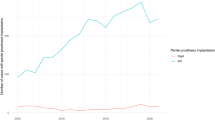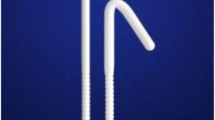Abstract
Purpose
This study aims to analyze patient demographics, hospital characteristics, and clinical risk factors which predict penile prosthesis removal. We also examine costs of penile prosthesis removal and trends in inflatable versus non-inflatable penile prostheses implantation in the USA from 2003 to 2015.
Methods
Cross-sectional analysis from Premier Perspective Database was completed using data from 2003 to 2015. We compared the relative proportion of inflatable versus non-inflatable penile prostheses implanted. We separated the prosthesis removal group based on indication for removal—Group 1 (infection), Group 2 (mechanical complication), and Group 3 (all explants). All groups were compared to a control group of patients with penile implants who were never subsequently explanted. Multivariate analysis was performed to analyze patient and hospital factors which predicted removal. Cost comparison was performed between the explant groups.
Results
There were 5085 penile prostheses implanted with a stable relative proportion of inflatable versus non-inflatable prosthesis over the 13-year study period. There were 3317 explantations. Patient factors associated with prosthesis removal were non-black race, Charlson Comorbidity Index, diabetes, and HIV status. Hospital factors associated with removal included non-teaching status, hospital region, year of removal, and annual surgeon volume. Median hospitalization costs of all explantations were $10,878. Explantations due to infection cost $11,252 versus $8602 for mechanical complications.
Conclusions
This large population-based study demonstrates a stable trend in inflatable versus non-inflatable prosthesis implantation. We also identify patient and hospital factors that predict penile prosthesis removal which has clinical utility for patient risk stratification and counseling.

Similar content being viewed by others
References
Mulcahy JJ (2010) Current approach to the treatment of penile implant infections. Ther Adv Urol 2(2):69–75
Wilson SK, Delk JR, Salem EA, Cleves MA (2007) Long-term survival of inflatable penile prostheses: single surgical group experience with 2,384 first-time implants spanning two decades. J Sex Med 4:1074–1079
Trost L, Wanzek P, Bailey G (2016) A practical overview of considerations for penile prosthesis placement. Nat Rev Urol 12:33–46
Chung E (2017) Penile prosthesis implant: scientific advances and technological innovations over the last four decades. Transl Androl Urol 6(1):37–45
Nielsen KT, Bruskewitz RC (1989) Semirigid and malleable rod penile prostheses. Urol Clin N Am 16:13–23
Grewal S, Vetter J, Brandes SB, Strope SA (2014) A Population-based analysis of contemporary rates of reoperation for penile prosthesis procedures. Urology 84(1):112–116
Jarrow JP (1996) Risk factors for penile prosthetic infection. J Urol 156(2 Pt 1):402–404
Govier FE, Gibbons RP, Correa RJ, Pritchett TR, Kramer-Levien D (1998) Mechanical reliability, surgical complications and patients partner satisfaction of the modern three-piece inflatable penile prosthesis. Urology 52(2):282–286
Montague DK, Angermeier KW, Lakin MM (2001) Penile prosthesis infections. Int J Impot Res 13(6):326–328
Wilson SK, Zumbe J, Henry GD, Delk JR, Cleves MA (2007) Infection reduction using antibiotic-coated inflatable penile prosthesis. Urology 70(2):337–340
Carson CC III, Mulcahy JJ, Harsch MR (2011) Long-term infection outcomes after original antibiotic impregnated inflatable penile prosthesis implants: up to 7.7 years of followup. J Urol 185(2):614–618
Lotan Y, Roehrborn CG, McConnell JD, Hendin BN (2003) Factors influencing the outcomes of penile prosthesis surgery at teaching institutions. Urology 62(5):918–921
Trost L, Hellstrom WJ (2013) History, contemporary outcomes, and future penile prosthesis: a review of the literature. Sex Med Rev 1:150–163
Eid JF (2016) Penile implant: review of a “No-Touch” technique. Sex Med Rev 4(3):294–300
Ko OS, Bennett NE Jr (2018) Ambicor two-piece inflatable penile prosthesis: background and contemporary outcomes. Sex Med Rev 6(2):319–327
Levine LA, Estrada CR, Morgentaler A (2001) Mechanical reliability and safety of, and patient satisfaction with the Ambicor inflatable penile prosthesis: results of a 2 center study. J Urol 166(3):932–937
Lux M, Reyes-Vallejo L, Morgentaler A, Levine LA (2007) Outcomes and satisfaction rates for redesigned 2-piece penile prosthesis. J Urol 177(1):262–266
Premier (2014) Research resources. Premier Inc. https://www.premierinc.com/wpdm-package/research. Accessed 4 May 2018
Charlson ME, Pompei P, Ales KL, MacKenzie CR (1987) A new method of classifying prognostic comorbidity in longitudinal studies: development and validation. J Chronic Dis 40(5):373–383
Quan H, Parsons GA, Ghali WA (2002) Validity of information on comorbidity derived from ICD-9-CCM administrative data. Med Care 40:675–685
Alwaal A, Harris CR, Hussein AA, Sanford TH, McCulloch CE, Shindel AW, Breyer BN (2015) The decline of inpatient penile prosthesis over the 10-year period, 2000–2010. Sex Med 3(4):280–286
Radomski SB, Herschorn S (1992) Risk factors associated with penile prosthesis infection. J Urol 147(2):383–385
Cakan M, Demirel F, Karabacak O, Yalçinkaya F, Altuğ U (2003) Risk factors for penile prosthetic infection. Int Urol Nephrol 35(2):209–213
Carson CC, Robertson CN (1988) Late hematogenous infection of penile prostheses. J Urol 139(1):50–52
Little JW, Rhodus NL (1992) The need for antibiotic prophylaxis of patients with penile implants during invasive dental procedures: a national survey of urologists. J Urol 148(6):1801–1804
Wilson SK, Delk JR II (1995) Inflatable penile implant infection: predisposing factors and treatment suggestions. J Urol 153(3 Pt 1):659–661
Pineda M, Burnett AL (2016) Penile prosthesis infections—a review of risk factors, prevention, and treatment. Sex Med Rev 4(4):389–398
Montague DK, Angermeier KW, Lakin MM (2001) Penile prosthesis infections. Int J Impot Res 13(6):323–328
Author information
Authors and Affiliations
Contributions
KL: protocol/project development, data management, data analysis, manuscript writing/editing. ERB: manuscript writing/editing. SLC: protocol/project development. JJL: protocol/project development, data collection. BIC: data collection, data management. YW: data analysis. JRE: protocol/project development, manuscript writing/editing.
Corresponding author
Ethics declarations
Conflict of interest
The authors declare that they have no conflict of interest.
Statement of human rights
For this type of study formal consent is not required.
Statement on the welfare of animals
This article does not contain any studies with human participants or animals performed by any of the authors.
Informed consent
No individual participants were included in this study. Data from this study was obtained retrospectively from a database without patient identifiers.
Rights and permissions
About this article
Cite this article
Li, K., Brandes, E.R., Chang, S.L. et al. Trends in penile prosthesis implantation and analysis of predictive factors for removal. World J Urol 37, 639–646 (2019). https://doi.org/10.1007/s00345-018-2491-4
Received:
Accepted:
Published:
Issue Date:
DOI: https://doi.org/10.1007/s00345-018-2491-4




